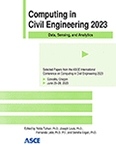Comparison of 3D Reconstruction between Neural Radiance Fields and Structure-from-Motion-Based Photogrammetry from 360° Videos
Publication: Computing in Civil Engineering 2023
ABSTRACT
Imagery is a standard modality of visual data capture on construction sites for documenting construction progress. Assimilating the data from multiple disjointed 2D images into a single 3D format enhances visualization and scene understanding and increases the data usability for tasks like quantity estimation and progress tracking. Two popular methods for 3D reconstruction are structure-from-motion (SfM)-based photogrammetry and neural radiance fields (NeRF), a neural network-based technique in computer vision. In this paper, we compare the spatial geometric accuracy of 3D reconstruction from 360° videos of construction sites using the SfM library called Colmap and NeRF. Our experiments show that 3D reconstruction from conventional photogrammetry is sharper than NeRF and more accurate in capturing object details and boundaries.
Get full access to this article
View all available purchase options and get full access to this chapter.
REFERENCES
Bansal, R., G. Raj, and T. Choudhury. 2016. “Blur Image Detection Using Laplacian Operator and Open-CV.” In 2016 International Conference System Modeling & Advancement in Research Trends (SMART), 63–67. https://doi.org/10.1109/SYSMART.2016.7894491.
Barbosa, A. S., and D. B. Costa. 2022. “Use of BIM and Visual Data Collected by UAS and 360° Camera for Construction Progress Monitoring.” IOP Conference Series: Earth and Environmental Science 1101 (8): 082007. https://doi.org/10.1088/1755-1315/1101/8/082007.
Braun, A., S. Tuttas, A. Borrmann, and U. Stilla. 2020. “Improving Progress Monitoring by Fusing Point Clouds, Semantic Data and Computer Vision.” Automation in Construction 116 (August): 103210. https://doi.org/10.1016/j.autcon.2020.103210.
Condorelli, F., F. Rinaudo, F. Salvadore, and S. Tagliaventi. 2021. “A Comparison between 3d Reconstruction Using Nerf Neural Networks and Mvs Algorithms on Cultural Heritage Images.” The International Archives of the Photogrammetry, Remote Sensing and Spatial Information Sciences XLIII-B2-2021 (June): 565–70. https://doi.org/10.5194/isprs-archives-XLIII-B2-2021-565-2021.
Debevec, P. E., C. J. Taylor, and J. Malik. n.d. “Modeling and Rendering Architecture from Photographs: A Hybrid Geometry- and Image-Based Approach.” Conference Proceedings.
Gao, K., Y. Gao, H. He, D. Lu, L. Xu, and J. Li. 2022. “NeRF: Neural Radiance Field in 3D Vision, A Comprehensive Review.” arXiv. http://arxiv.org/abs/2210.00379.
Hossan, M., and A. Nadeem. 2019. Towards Digitizing the Construction Industry: State of the Art of Construction 4.0. Proceedings of International Structural Engineering and Construction. Vol. 6. https://doi.org/10.14455/ISEC.res.2019.184.
Kim, S., S. Kim, and D.-E. Lee. 2020. “Sustainable Application of Hybrid Point Cloud and BIM Method for Tracking Construction Progress.” Sustainability 12 (10): 4106. https://doi.org/10.3390/su12104106.
Kutulakos, K. N., and S. M. Seitz. 1999. “A Theory of Shape by Space Carving.” In Proceedings of the Seventh IEEE International Conference on Computer Vision, 307–14 vol.1. Kerkyra, Greece: IEEE. https://doi.org/10.1109/ICCV.1999.791235.
Mildenhall, B., P. P. Srinivasan, M. Tancik, J. T. Barron, R. Ramamoorthi, and R. Ng. 2020. “NeRF: Representing Scenes as Neural Radiance Fields for View Synthesis.” arXiv. https://doi.org/10.48550/arXiv.2003.08934.
Palestini, C., A. Basso, and M. Perticarini. 2022. “Machine Learning as an Alternative to 3d Photomodeling Employed in Architectural Survey and Automatic Design Modelling.” The International Archives of the Photogrammetry, Remote Sensing and Spatial Information Sciences XLVIII-2/W1-2022 (December): 191–97. https://doi.org/10.5194/isprs-archives-XLVIII-2-W1-2022-191-2022.
Schonberger, J. L., and J.-M. Frahm. 2016. “Structure-from-Motion Revisited.” In 2016 IEEE Conference on Computer Vision and Pattern Recognition (CVPR), 4104–13. Las Vegas, NV, USA: IEEE. https://doi.org/10.1109/CVPR.2016.445.
Teizer, J., C. H. Caldas, and C. T. Haas. 2007. “Real-Time Three-Dimensional Occupancy Grid Modeling for the Detection and Tracking of Construction Resources.” Journal of Construction Engineering and Management 133 (11): 880–88. https://doi.org/10.1061/(ASCE)0733-9364(2007)133:11(880).
Information & Authors
Information
Published In
History
Published online: Jan 25, 2024
ASCE Technical Topics:
- Building codes
- Comparative studies
- Computer networks
- Computer vision and image processing
- Computing in civil engineering
- Construction engineering
- Construction management
- Construction sites
- Detection methods
- Engineering fundamentals
- Geomatics
- Methodology (by type)
- Photogrammetry
- Research methods (by type)
- Standards and codes
- Surveying methods
- Tracking
Authors
Metrics & Citations
Metrics
Citations
Download citation
If you have the appropriate software installed, you can download article citation data to the citation manager of your choice. Simply select your manager software from the list below and click Download.
